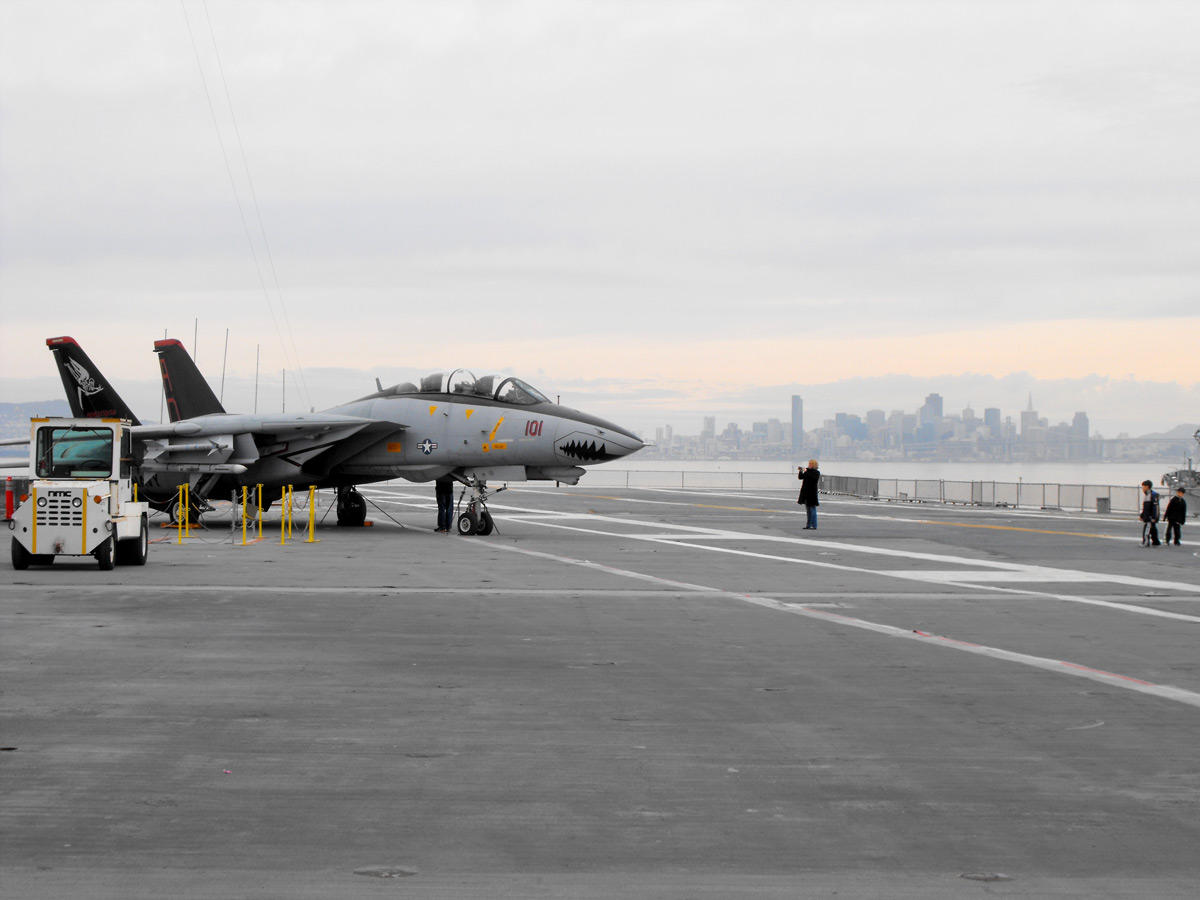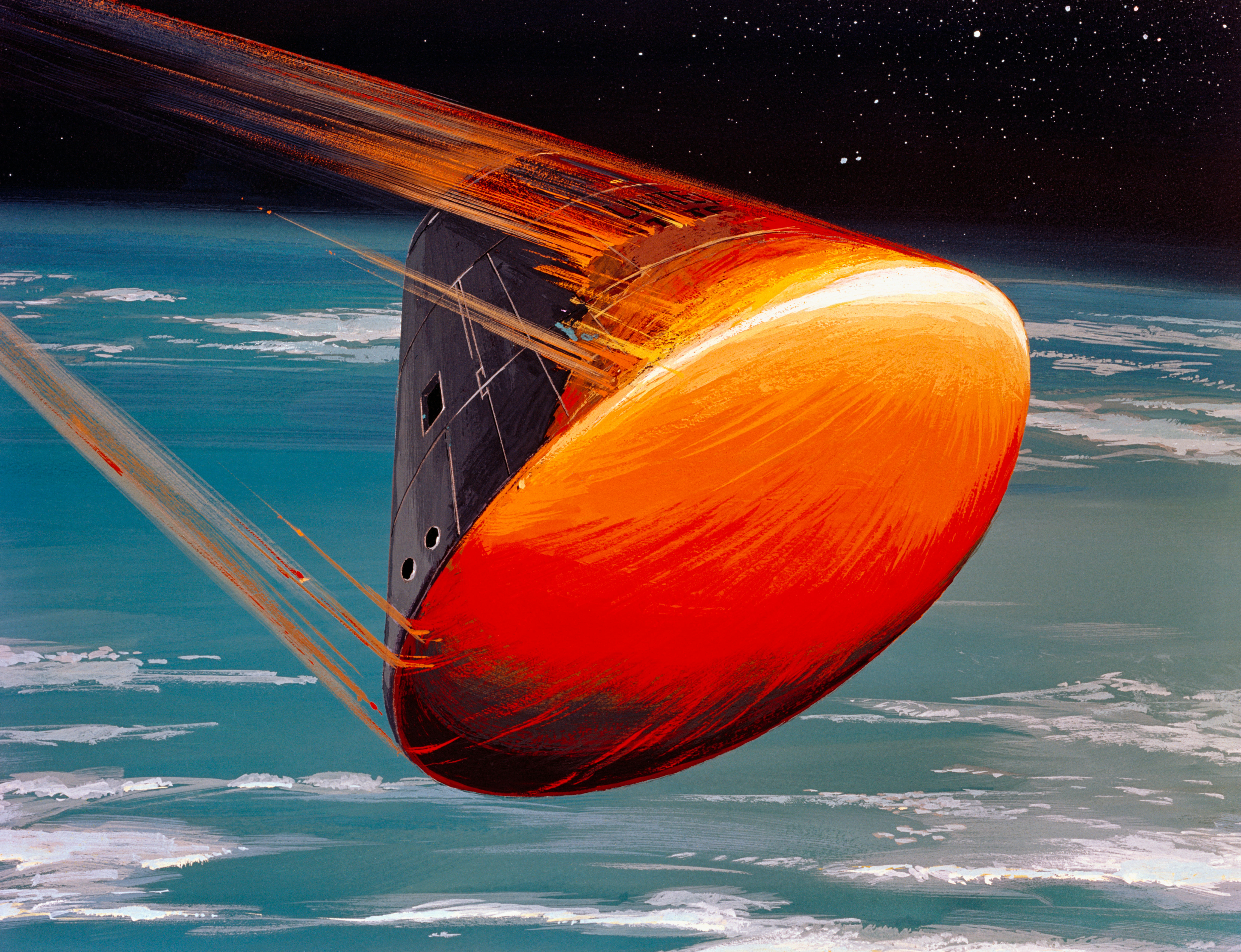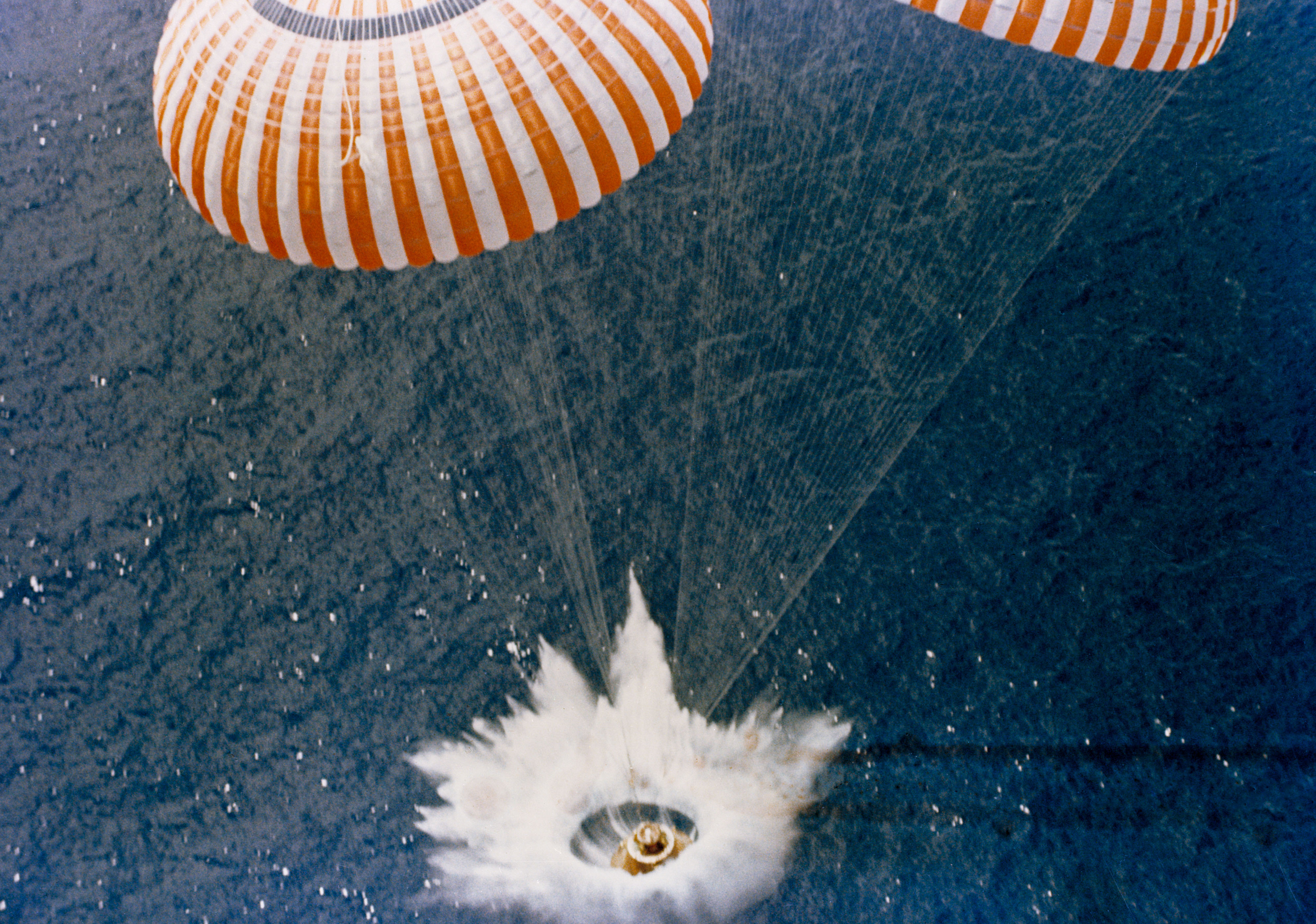|
AS-202
AS-202 (also referred to as SA-202) was the second uncrewed, suborbital test flight of a production Block I Apollo command and service module launched with the Saturn IB launch vehicle. It was launched on August 25, 1966, and was the first flight which included the spacecraft guidance, navigation control system and fuel cells. The success of this flight enabled the Apollo program to judge the Block I spacecraft and Saturn IB ready to carry men into orbit on the next mission, AS-204. Objectives AS-202 was the third test flight of the Saturn IB, because a delay in the readiness of the Apollo spacecraft 011 pushed its launch past the July 1966 launch of AS-203. It was designed to test the rocket more than had been done on AS-201 by launching the rocket higher and having the flight lasting twice as long. It would also test the command and service module (CSM-011) by having the engine fire four times during the flight. The flight was also designed to test the heat shield by sub ... [...More Info...] [...Related Items...] OR: [Wikipedia] [Google] [Baidu] |
AS-203
AS-203 (or SA-203) was an uncrewed flight of the Saturn IB rocket on July 5, 1966. It carried no command and service module, as its purpose was to verify the design of the S-IVB rocket stage restart capability that would later be used in the Apollo program to boost astronauts from Earth orbit to a trajectory towards the Moon. It achieved its objectives, but the stage was inadvertently destroyed after four orbits. Objectives The purpose of the AS-203 flight was to investigate the effects of weightlessness on the liquid hydrogen fuel in the S-IVB-200 second-stage tank. The lunar missions would use a modified version of the S-IVB-200, the S-IVB-500, as the third stage of the Saturn V launch vehicle. This called for the stage to fire briefly to put the spacecraft into a parking Earth orbit, before restarting the engine for flight to the Moon. In order to design this capability, engineers needed to verify that the anti-slosh measures designed to control the hydrogen's location in th ... [...More Info...] [...Related Items...] OR: [Wikipedia] [Google] [Baidu] |
Apollo 1
Apollo 1, initially designated AS-204, was intended to be the first crewed mission of the Apollo program, the American undertaking to land the first man on the Moon. It was planned to launch on February 21, 1967, as the first low Earth orbital test of the Apollo command and service module. The mission never flew; a cabin fire during a launch rehearsal test at Cape Kennedy Air Force Station Launch Complex 34 on January 27 killed all three crew members—Command Pilot Gus Grissom, Senior Pilot Ed White, and Pilot Roger B. Chaffee—and destroyed the command module (CM). The name Apollo 1, chosen by the crew, was made official by NASA in their honor after the fire. Immediately after the fire, NASA convened an Accident Review Board to determine the cause of the fire, and both chambers of the United States Congress conducted their own committee inquiries to oversee NASA's investigation. The ignition source of the fire was determined to be electrical, and the fire spread rapi ... [...More Info...] [...Related Items...] OR: [Wikipedia] [Google] [Baidu] |
USS Hornet Museum
The USS ''Hornet'' Museum is a museum ship, located on the southernmost pier of the former Naval Air Station Alameda in Alameda, California, US. The museum is composed of the aircraft carrier , exhibits from the NASA Apollo Moon exploration missions, and several retired aircraft from the Second World War and the transonic and early supersonic jet propulsion period. A number of compartments contain exhibits concerning contemporary carriers that are supported by related associations. The flight deck, hangar deck, and first deck below are open for self-guided tours. Docent-led tours are available into the ship's navigation and flight deck control areas of the island and down into one of the engineering spaces containing two of the four ship's propulsion turbines. Mission statement Aircraft Carrier Hornet Foundation preserves and honors the legacy of , a national historic landmark, and its role in naval aviation, the defense of the United States, the Apollo Program, and explorat ... [...More Info...] [...Related Items...] OR: [Wikipedia] [Google] [Baidu] |
1966 In Spaceflight
The year 1966 saw the peak and the end of the Gemini program. The program proved that docking in space and human EVA's could be done safely. It saw the first launch of the Saturn IB rocket, an important step in the Apollo program, and the launch of Luna 9 Luna 9 (Луна-9), internal designation Ye-6 No.13, was an uncrewed space mission of the Soviet Union's Luna programme. On 3 February 1966, the Luna 9 spacecraft became the first spacecraft to achieve a survivable landing on a celestial body ..., the first spacecraft to make a soft landing on a celestial object (the Moon). Launches , colspan=8, January , - , colspan=8, February , - , colspan=8, March , - , - , - , - , - , - , - , - , - , - , - , - , colspan=8, April , - , - , - , - , - , - , - , - , - , colspan=8, May , - , - , - , - , - , - , - , - , - , - , - , - , - , - , colspan=8, June , - , - , - , - , - , - , - , - , - , - , - , ... [...More Info...] [...Related Items...] OR: [Wikipedia] [Google] [Baidu] |
Apollo Command Module
The Apollo command and service module (CSM) was one of two principal components of the United States Apollo spacecraft, used for the Apollo program, which landed astronauts on the Moon between 1969 and 1972. The CSM functioned as a mother ship, which carried a crew of three astronauts and the second Apollo spacecraft, the Apollo Lunar Module, to lunar orbit, and brought the astronauts back to Earth. It consisted of two parts: the conical command module, a cabin that housed the crew and carried equipment needed for atmospheric reentry and splashdown; and the cylindrical service module which provided propulsion, electrical power and storage for various consumables required during a mission. An umbilical connection transferred power and consumables between the two modules. Just before reentry of the command module on the return home, the umbilical connection was severed and the service module was cast off and allowed to burn up in the atmosphere. The CSM was developed and built ... [...More Info...] [...Related Items...] OR: [Wikipedia] [Google] [Baidu] |
S-IVB
The S-IVB (pronounced "S-four-B") was the third stage on the Saturn V and second stage on the Saturn IB launch vehicles. Built by the Douglas Aircraft Company, it had one J-2 rocket engine. For lunar missions it was fired twice: first for Earth orbit insertion after second stage cutoff, and then for translunar injection (TLI). History The S-IVB evolved from the upper stage of the Saturn I rocket, the S-IV, and was the first stage of the Saturn V to be designed. The S-IV used a cluster of six engines but used the same fuels as the S-IVB – liquid hydrogen and liquid oxygen. It was also originally meant to be the fourth stage of a planned rocket called the C-4, hence the name S-IV. Eleven companies submitted proposals for being the lead contractor on the stage by the deadline of 29 February 1960. NASA administrator T. Keith Glennan decided on 19 April that Douglas Aircraft Company would be awarded the contract. Convair had come a close second but Glennan did not want to monopol ... [...More Info...] [...Related Items...] OR: [Wikipedia] [Google] [Baidu] |
Service Propulsion System
The Apollo command and service module (CSM) was one of two principal components of the United States Apollo spacecraft, used for the Apollo program, which landed astronauts on the Moon between 1969 and 1972. The CSM functioned as a mother ship, which carried a crew of three astronauts and the second Apollo spacecraft, the Apollo Lunar Module, to lunar orbit, and brought the astronauts back to Earth. It consisted of two parts: the conical command module, a cabin that housed the crew and carried equipment needed for atmospheric reentry and splashdown; and the cylindrical service module which provided propulsion, electrical power and storage for various consumables required during a mission. An umbilical connection transferred power and consumables between the two modules. Just before reentry of the command module on the return home, the umbilical connection was severed and the service module was cast off and allowed to burn up in the atmosphere. The CSM was developed and built ... [...More Info...] [...Related Items...] OR: [Wikipedia] [Google] [Baidu] |
Apollo CSM
The Apollo command and service module (CSM) was one of two principal components of the United States Apollo spacecraft, used for the Apollo program, which landed astronauts on the Moon between 1969 and 1972. The CSM functioned as a mother ship, which carried a crew of three astronauts and the second Apollo spacecraft, the Apollo Lunar Module, to lunar orbit, and brought the astronauts back to Earth. It consisted of two parts: the conical command module, a cabin that housed the crew and carried equipment needed for atmospheric reentry and splashdown; and the cylindrical service module which provided propulsion, electrical power and storage for various consumables required during a mission. An umbilical connection transferred power and consumables between the two modules. Just before reentry of the command module on the return home, the umbilical connection was severed and the service module was cast off and allowed to burn up in the atmosphere. The CSM was developed and built ... [...More Info...] [...Related Items...] OR: [Wikipedia] [Google] [Baidu] |
Apollo Command And Service Module
The Apollo command and service module (CSM) was one of two principal components of the United States Apollo spacecraft, used for the Apollo program, which landed astronauts on the Moon between 1969 and 1972. The CSM functioned as a mother ship, which carried a crew of three astronauts and the second Apollo spacecraft, the Apollo Lunar Module, to lunar orbit, and brought the astronauts back to Earth. It consisted of two parts: the conical command module, a cabin that housed the crew and carried equipment needed for atmospheric reentry and splashdown; and the cylindrical service module which provided propulsion, electrical power and storage for various consumables required during a mission. An umbilical connection transferred power and consumables between the two modules. Just before reentry of the command module on the return home, the umbilical connection was severed and the service module was cast off and allowed to burn up in the atmosphere. The CSM was developed and buil ... [...More Info...] [...Related Items...] OR: [Wikipedia] [Google] [Baidu] |
Cape Canaveral Air Force Station Launch Complex 34
Launch Complex 34 (LC-34) is a deactivated launch site on Cape Canaveral Space Force Station, Florida. LC-34 and its companion LC-37 to the north were used by NASA from 1961 through 1968 to launch Saturn I and IB rockets as part of the Apollo program. It was the site of the Apollo 1 fire, which claimed the lives of astronauts Gus Grissom, Ed White, and Roger Chaffee on January 27, 1967. The first crewed Apollo launch — Apollo 7 on October 11, 1968 — was the last time LC-34 was used. History Construction Work began on LC-34 in 1960, and it was formally dedicated on June 5, 1961. The complex consisted of a launch platform, umbilical tower, mobile service tower, fueling facilities, and a blockhouse. Two steel flame deflectors were mounted on rails to allow placement beneath the launch platform. The service tower was likewise mounted on rails, and it was moved to a position 185 meters west of the pad before launch. At 95 meters high, it was the tallest structure at LC-34. ... [...More Info...] [...Related Items...] OR: [Wikipedia] [Google] [Baidu] |
Splashdown
Splashdown is the method of landing a spacecraft by parachute in a body of water. It was used by crewed American space capsules prior to the Space Shuttle program, by SpaceX Dragon and Dragon 2 capsules and by NASA's Orion Multipurpose Crew Vehicle. It is also possible for the Russian Soyuz spacecraft to land in water, though this is only a contingency. The only example of an unintentional crewed splashdown in Soviet history is the Soyuz 23 landing. As the name suggests, the capsule parachutes into an ocean or other large body of water. The properties of water cushion the spacecraft enough that there is no need for a braking rocket to slow the final descent as is the case with Russian and Chinese crewed space capsules (while Shenzhou designed a raft and balanced capsule in case of splashdown), which return to Earth over land. The American practice came in part because American launch sites are on the coastline and launch primarily over water. Russian launch sites are far ... [...More Info...] [...Related Items...] OR: [Wikipedia] [Google] [Baidu] |
Cape Canaveral Air Force Station
Cape Canaveral Space Force Station (CCSFS) is an installation of the United States Space Force's Space Launch Delta 45, located on Cape Canaveral in Brevard County, Florida. Headquartered at the nearby Patrick Space Force Base, the station is the primary launch site for the Space Force's Eastern RangeCAST 1999, p. 1-12. with three launch pads currently active (Space Launch Complexes 37B, 40, and 41). The facility is south-southeast of NASA's Kennedy Space Center on adjacent Merritt Island, with the two linked by bridges and causeways. The Cape Canaveral Space Force Station Skid Strip provides a runway close to the launch complexes for military airlift aircraft delivering heavy and outsized payloads to the Cape. A number of American space exploration pioneers were launched from CCSFS, including the first U.S. Earth satellite (1958), first U.S. astronaut (1961), first U.S. astronaut in orbit (1962), first two-man U.S. spacecraft (1965), first U.S. unmanned lunar ... [...More Info...] [...Related Items...] OR: [Wikipedia] [Google] [Baidu] |








